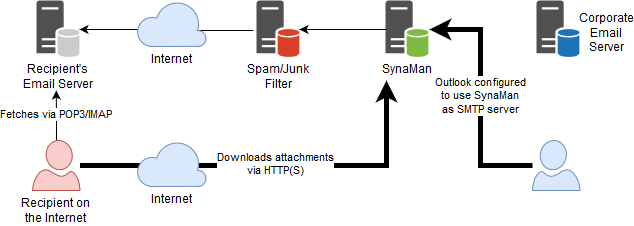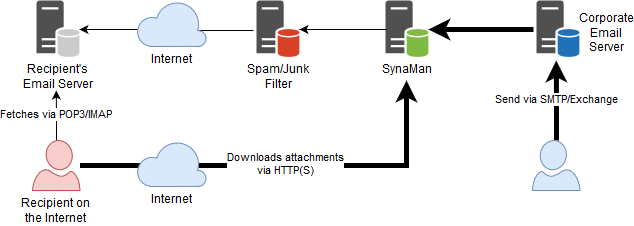Synametrics Technologies
Revolving around the core of technology
Deployment Scenarios Embedded SMTP Server
The Embedded SMTP Server in SynaMan is a special server that can extract large attachments from an existing email and sends the remaining message body to the final recipient. Beside detaching the files, it adds a URL in the message body allowing the recipients to download the originally attached files from a web server. This page describes different scenarios on how you can install the Embedded SMTP Server in SynaMan within your network.The Goal
An important goal to keep in mind when deploying SynaMan is that you want SynaMan as close as possible to the user's email client. This means, ideally, it should be the first SMTP server. However, this goal is sometimes not practical because of different complexities that exists in corporate networks. This page tries to demonstrate different deployment scenarios and you pick the best that fits your network typology.Inbound Emails
Click a desired heading below to expand.
In this scenario SynaMan is configured to receive every email coming in from the Internet.


End-users on your LAN can download large attachments via HTTP from SynaMan's web interface.


Description
SMTP traffic (TCP port 25) gets forwarded to the machine where SynaMan is installed. Every incoming email from the Internet hits SynaMan. Messages with large attachments are modified while smaller emails are forwarded as-is to the next hop, which can either be your corporate email server or a spam filter.End-users on your LAN can download large attachments via HTTP from SynaMan's web interface.
Pros
- This is the first SMTP server that gets any out-bound email. Therefore, the servers behind it do not have to parse large attachments.
Cons
- Spam filters prefer to be the first SMTP server. If you put SynaMan in front of a spam filter, every message coming into the spam filter will appear to come from SynaMan, which can negatively affect filtering.
SynaMan is the second SMTP server to receive emails.


End-users on your LAN can download large attachments via HTTP from SynaMan's web interface.


Description
SynaMan receives emails after getting filtered by your spam filter. This means you will have to configure your spam filter not to reject large attachments. Keep in mind that if your spam filter rejects an incoming email because it is too big, message will never reach SynaMan.End-users on your LAN can download large attachments via HTTP from SynaMan's web interface.
Pros
- Spam filter will work better.
Cons
- Large messages may never reach SynaMan if spam filter cannot handle it.
You will have to use Xeams in order for this to work. Xeams is an excellent
email server with built-in spam filtering capabilities and is tightly integrated with SynaMan.


Communication between Xeams and SynaMan is done over HTTP(S), not SMTP, allowing Xeams to apply filters efficiently on messages with large attachments.
End-users on your LAN can download large attachments via HTTP from SynaMan's web interface.


Description
In this case, Xeams is configured to filter spam/junk messages and will communicate with SynaMan whenever a large email is received. SynaMan will detach the attachment and forward the remaining message back to Xeams, which will apply filtering rules and will eventually forward the message to your corporate email server.Communication between Xeams and SynaMan is done over HTTP(S), not SMTP, allowing Xeams to apply filters efficiently on messages with large attachments.
End-users on your LAN can download large attachments via HTTP from SynaMan's web interface.
Pros
- This is the first SMTP server that gets any out-bound email. Therefore, the servers behind it do not have to parse large attachments.
Cons
- None
Outbound Emails
Click a desired heading below to expand.
Email clients send their out-bound emails to SynaMan's SMTP server.


Final recipients on the Internet will be able to download large attachments via HTTP from SynaMan's web interface.


Description
You configure every email client, such as MS Outlook or Mozilla Thunderbird, to send out-bound emails to SynaMan. SynaMan will deliver the message to its final destination or to a spam filter within your network.Final recipients on the Internet will be able to download large attachments via HTTP from SynaMan's web interface.
Pros
- This is the first SMTP server and therefore, you will achieve the ideal deployment scenario
Cons
- You will have to configure every email client, which may not be practical for a large organization.
SynaMan receives emails from your corporate email server.


Final recipients on the Internet will be able to download large attachments via HTTP from SynaMan's web interface.


Description
Outbound messages are sent to your corporate email server, which then forwards them to SynaMan. Most email servers can be configured to use a Smart Host. You configure this smart host so out-bound messages go through SynaMan.Final recipients on the Internet will be able to download large attachments via HTTP from SynaMan's web interface.
Pros
- Easier to configure.
Cons
- You will have to configure your corporate email server to handle large emails.
Related Articles
- Embedded SMTP Server in SynaMan
- Configuring outbound settings for embedded SMTP server.
